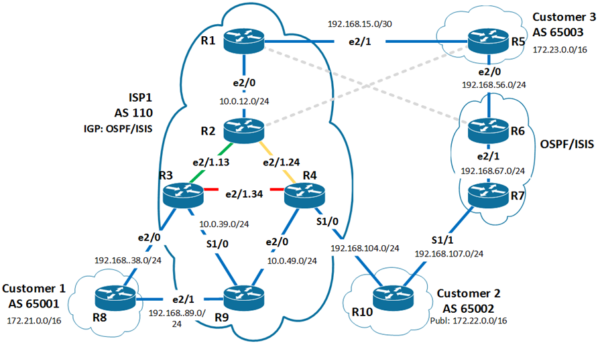Cloud Computing
Vedúci výskumu prof. Ing. Pavel Segeč, PhD., Ing. Marek Moravčík, PhD.
Department of information networks operates the OpenStack Cloud Computing (CC) infrastructure, which is used for education and research activities. Virtualization of network devices such as routers, switches and firewalls allows the provision of Infrastructure as a Service (IaaS).
In the picture below, there is basic topology we are using during lectures in engineering degree. We are trying to provide as much network devices as we can. Mainly, we focus on Cisco Systems, but thanks to virtualization we are able to provide devices from more vendors, such as Juniper networks, MikroTik or Fortinet. We find this crucial for students’ practical skills to get familiar with multivendor environment. Because these are virtual devices, we are able to run them as long as we need, so students and teachers can learn from any place, they are not tied to laboratory. Another benefit is, that they can simulate almost whatever topology on demand, if they need to troubleshoot some problem.

Resource allocation and documentation is supported by a software system called as the Cloud Administration System (CAS). Cloud users – teachers and students, can automatically create the required devices according to their requirements. To the administrator CAS provides necessary documentation and statistics of the created devices.
Our department is also working with network devices virtualization. One of our projects is called ViRo (Virtual Router). The goal of ViRo is to provide on-line, internet-accessible educational tool that allows students, regardless of their software and hardware options, remote access to a using network server. The server will be implemented with freely distributed and platform independent emulator of computer networks, Dynamips/Dynagen which supports only Cisco devices, and KVM/QEMU, which supports other vendors (Juniper, MikroTik, …) and end devices, such as Linux and Windows.
The management interface tool provides a number of functions available through the internet and fully functional simulator of computer networks for the users. ViRo tool requires no additional installation of other software on the client computer. The tool provides the user with a laboratory environment that emulates the real network topology with which students work on practical exercises during the Computer networks courses implemented at two faculties of the University of Zilina, Faculty of Management Science. The solution offers a number of advantages, such as the central management of network topologies and sets of exercises, management of operating systems for network elements, transfer of computing performance requirements of the simulations to a powerful and centrally managed network server, management of server load and use, process, personnel and time management, communication with real network, etc.
Cloud computing (CC) infrastructure provides opportunities for creating different kinds of cloud services. In the context of the research topic Cyber Security, Security as a Service (SECaaS) is the most significant service. It is provided through the Information Security Management System (ISMS). Its development respects the architectural approach according to ISO / IEC / IEEE 42010 Systems and Software Engineering, in accordance with the norm ISO / IEC 27 000 and the corresponding CC reference architecture. The development of ISMS has the following phases.
- Security requirements determination.
- Security risk assessment.
- Arrangement to reduce security risk.
ISMS software support will enable automation of many SECaaS development activities and necessary document archiving for future service audit in a specific environment. This research is carried out at the time of writing that document.
References
[1] M. Moravčík et al.: Clouds in educational process, in ICETA 2015: 13th IEEE international conference on Emerging eLearning technologies and applications, November 26-27, 2015, Starý Smokovec, Slovakia 2015, ISBN 978-1-4673-8534-3, s 269-275.
[2] M. Moravčík et al.: Overview of cloud computing and portability problems, in ICETA 2017 15th IEEE international conference on Emerging eLearning technologies and applications, November 26-27, 2017, Starý Smokovec, The High Tatras, Slovakia, 2017, ISBN 978-1-5386-3296-3, s 313-318.
[3] M. Moravčík et al.: Teaching cloud computing in cloud computing, in ICETA 2017 15th IEEE international conference on Emerging eLearning technologies and applications, November 26-27, 2017, Starý Smokovec, The High Tatras, Slovakia, 2017, ISBN 978-1-5386-3296-3, s 319-324.
[4] M. Drozdová et al.: Contribution to cloud computing security architecture, in ICETA 2017 15th IEEE international conference on Emerging eLearning technologies and applications, November 26-27, 2017, Starý Smokovec, The High Tatras, Slovakia, 2017, ISBN 978-1-5386-3296-3, s 117-122.
[5] M. Moravčík et al.: Overview of cloud computing standards, in ICETA 2018 16th IEEE international conference on Emerging eLearning technologies and applications, November 15-16, 2018, Starý Smokovec, The High Tatras, Slovakia, 2018, ISBN 978-1-5386-7914-2, s 395-402.
[6] J. Uramová et al.: ViRo – The online support tool for IP network oriented courses, in ICETA 2012 10th IEEE international conference on Emerging eLearning technologies and applications, November 8-9, 2013, Starý Smokovec, The High Tatras, Slovakia, 2012, ISBN 978-1-4673-5122-5, s 339-343.